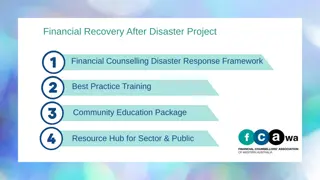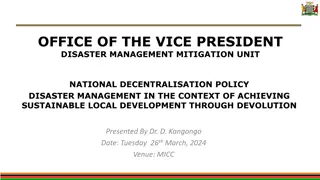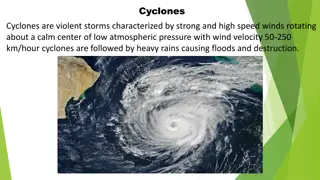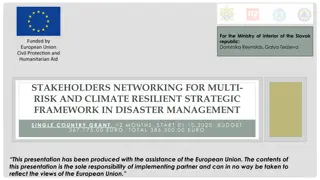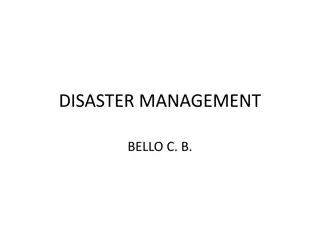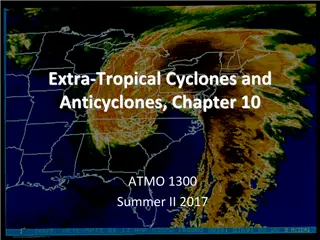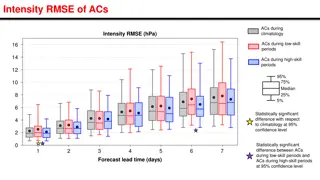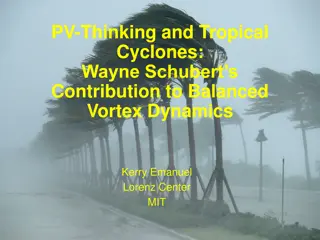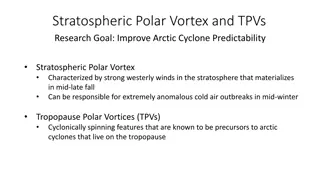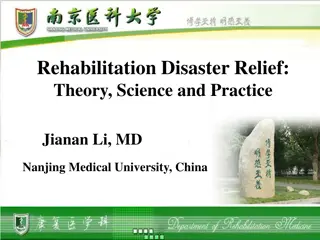Understanding Cyclones and Associated Phenomena in Disaster Management
Cyclones are large air masses characterized by swirling winds around a low-pressure center. Mesocyclones are vortexes within storms that can produce tornadoes. Dust devils and waterspouts are related phenomena, with dust devils ranging in size and potential threat levels. Other variations include steam devils and fire whirls, induced by heat sources. Tropical cyclones are rapid rotating storms typically seen in tropical regions.
Download Presentation

Please find below an Image/Link to download the presentation.
The content on the website is provided AS IS for your information and personal use only. It may not be sold, licensed, or shared on other websites without obtaining consent from the author. Download presentation by click this link. If you encounter any issues during the download, it is possible that the publisher has removed the file from their server.
E N D
Presentation Transcript
Disaster Management (Cyclone) Sem- VI
n meteorology, a cyclone (/sa.klon/) is a large air mass that rotates around a strong center of low atmospheric pressure, counterclockwise in the Northern Hemisphere and clockwise in the Southern Hemisphere as viewed from above (opposite to an anticyclone). Cyclones are characterized by inward-spiraling winds that rotate about a zone of low pressure
Mesocyclone Main article: Mesocyclone A mesocyclone is a vortex of air, 2.0 kilometres (1.2 mi) to 10 kilometres (6.2 mi) in diameter (the mesoscale of meteorology), within a convective storm.[60]Air rises and rotates around a vertical axis, usually in the same direction as low-pressure systems[61]in both northern and southern hemisphere. They are most often cyclonic, that is, associated with a localized low-pressure region within a supercell.[61][62]Such storms can feature strong surface winds and severe hail.[61] Mesocyclones often occur together with updrafts in supercells, where tornadoes may form.[61]About 1,700 mesocyclones form annually across the United States, but only half produce tornadoes.[13] Tornado Main article: Tornado A tornado is a violently rotating column of air that is in contact with both the surface of the earth and a cumulonimbus cloud or,[63]in rare cases, the base of a cumulus cloud. Also referred to as twisters, a colloquial term in America, or cyclones, although the word cyclone is used in meteorology, in a wider sense, to name any closed low-pressure circulation.
Dust devil Main article: Dust devil A dust devil is a strong, well-formed, and relatively long-lived whirlwind,[64]ranging from small (half a metre wide and a few metres tall) to large (more than 10 metres wide and more than 1000 metres tall).[64]The primary vertical motion is upward.[64]Dust devils are usually harmless, but can on rare occasions grow large enough to pose a threat to both people and property.[64] Waterspout Main article: Waterspout A waterspout is a columnar vortex forming over water that is, in its most common form, a non-supercell tornado over water that is connected to a cumuliform cloud. While it is often weaker than most of its land counterparts, stronger versions spawned by mesocyclones do occur.
Steam devil Main article: Steam devil A gentle vortex over calm water or wet land made visible by rising water vapour. Fire whirl Main article: Fire whirl A fire whirl also colloquially known as a fire devil, fire tornado, firenado, or fire twister is a whirlwind induced by a fire and often made up of flame or ash.
A tropical cyclone is a rapidly rotating storm system characterized by a low-pressure center, a closed low-level atmospheric circulation, strong winds, and a spiral arrangement of thunderstorms that produce heavy rain and squalls. Depending on its location and strength, a tropical cyclone is referred to by different names, including hurricane (/ h r k n, -ke n/), typhoon (/ta fu n/), tropical storm, cyclonic storm, tropical depression, or simply cyclone.[citation needed]A hurricane is a strong tropical cyclone that occurs in the Atlantic Ocean or northeastern Pacific Ocean, and a typhoon occurs in the northwestern Pacific Ocean. In the Indian Ocean, South Pacific, or (rarely) South Atlantic, comparable storms are referred to simply as "tropical cyclones", and such storms in the Indian Ocean can also be called "severe cyclonic storms".
Tropical cyclone basins and official warning centers Basin Warning center Area of responsibility Notes Northern Hemisphere North Atlantic United States National Hurricane Center Equator northward, African Coast 140 W Eastern Pacific United States Central Pacific Hurricane Center Equator northward, 140 180 W Western Pacific Japan Meteorological Agency Equator 60 N, 180 100 E North Indian Ocean India Meteorological Department Equator northwards, 100 40 E Southern Hemisphere South-West Indian Ocean M t o-France Reunion Equator 40 S, African Coast 90 E Australian region Indonesian Meteorology, Climatology, and Geophysical Agency (BMKG) Equator 10 S, 90 141 E ]Papua New Guinea National Weather Service Equator 10 S, 141 160 E Australian Bureau of Meteorology 10 40 S, 90 160 E southern Pacific Fiji Meteorological Service Equator 25 S, 160 E 120 W Meteorological Service of New Zealand 25 40 S, 160 E 120 W





